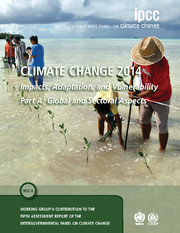 Climate Change 2014 – Impacts, Adaptation and Vulnerability: Part A: Global and Sectoral Aspects
Climate Change 2014 – Impacts, Adaptation and Vulnerability: Part A: Global and Sectoral Aspects Book contents
- Frontmatter
- Contents
- Foreword, Preface, and Dedication
- Summary for Policymakers
- Technical Summary
- Cross-Chapter Boxes
- Chapters 1-20
- Chapter 1 Point of Departure
- Chapter 2 Foundations for Decision Making
- Chapter 3 Freshwater Resources
- Chapter 4 Terrestrial and Inland Water Systems
- Chapter 5 Coastal Systems and Low-Lying Areas
- Chapter 6 Ocean Systems
- Chapter 7 Food Security and Food Production Systems
- Chapter 8 Urban Areas
- Chapter 9 Rural Areas
- Chapter 10 Key Economic Sectors and Services
- Chapter 11 Human Health: Impacts, Adaptation, and Co-Benefits
- Chapter 12 Human Security
- Chapter 13 Livelihoods and Poverty
- Chapter 14 Adaptation Needs and Options
- Chapter 15 Adaptation Planning and Implementation
- Chapter 16 Adaptation Opportunities, Constraints, and Limits
- Chapter 17 Economics of Adaptation
- Chapter 18 Detection and Attribution of Observed Impacts
- Chapter 19 Emergent Risks and Key Vulnerabilities
Chapter 2 - Foundations for Decision Making
Published online by Cambridge University Press: 05 January 2015
- Frontmatter
- Contents
- Foreword, Preface, and Dedication
- Summary for Policymakers
- Technical Summary
- Cross-Chapter Boxes
- Chapters 1-20
- Chapter 1 Point of Departure
- Chapter 2 Foundations for Decision Making
- Chapter 3 Freshwater Resources
- Chapter 4 Terrestrial and Inland Water Systems
- Chapter 5 Coastal Systems and Low-Lying Areas
- Chapter 6 Ocean Systems
- Chapter 7 Food Security and Food Production Systems
- Chapter 8 Urban Areas
- Chapter 9 Rural Areas
- Chapter 10 Key Economic Sectors and Services
- Chapter 11 Human Health: Impacts, Adaptation, and Co-Benefits
- Chapter 12 Human Security
- Chapter 13 Livelihoods and Poverty
- Chapter 14 Adaptation Needs and Options
- Chapter 15 Adaptation Planning and Implementation
- Chapter 16 Adaptation Opportunities, Constraints, and Limits
- Chapter 17 Economics of Adaptation
- Chapter 18 Detection and Attribution of Observed Impacts
- Chapter 19 Emergent Risks and Key Vulnerabilities
Summary
2.1. Introduction and Key Concepts
This chapter addresses the foundations of decision making with respect to climate impact, adaptation, and vulnerability (CIAV). The Fourth Assessment Report (AR4) summarized methods for assessing CIAV (Carter et al., 2007), which we build on by surveying the broader literature relevant for decision making.
Decision making under climate change has largely been modeled on the scientific understanding of the cause-and-effect process whereby increasing greenhouse gas emissions cause climate change, resulting in changing impacts and risks, potentially increasing vulnerability to those risks. The resulting decision-making guidance on impacts and adaptation follows a rational-linear process that identifies potential risks and then evaluates management responses (e.g., Carter et al., 1994; Feenstra et al., 1998; Parry and Carter, 1998; Fisher et al., 2007). This process has been challenged on the grounds that it does not adequately address the diverse contexts within which climate decisions are being made, often neglects existing decision-making processes, and overlooks many cultural and behavioral aspects of decision making (Smit and Wandel, 2006; Sarewitz and Pielke, 2007; Dovers, 2009; Beck, 2010). While more recent guidance on CIAV decision making typically accounts for sectoral, regional, and socioeconomic characteristics (Section 21.3), the broader decision-making literature is still not fully reflected in current methods. This is despite an increasing emphasis on the roles of societal impacts and responses to climate change in decision-making methodologies (high confidence) (Sections 1.1, 1.2, 21.2.1).
The main considerations that inform the decision-making contexts addressed here are knowledge generation and exchange, who makes and implements decisions, and the issues being addressed and how these can be addressed. These decisions occur within a broader social and cultural environment. Knowledge generation and exchange includes knowledge generation, development, brokering, exchange, and application to practice. Decision makers include policymakers, managers, planners, and practitioners, and range from individuals to organizations and institutions (Table 21-1).
- Type
- Chapter
- Information
- Climate Change 2014 – Impacts, Adaptation and Vulnerability: Part A: Global and Sectoral AspectsWorking Group II Contribution to the IPCC Fifth Assessment Report, pp. 195 - 228Publisher: Cambridge University PressPrint publication year: 2014
- 5
- Cited by
